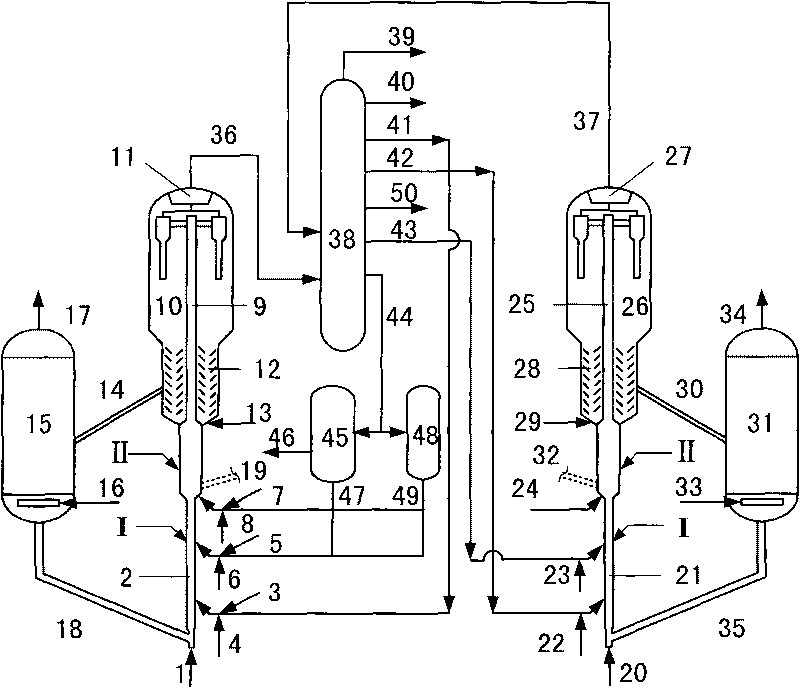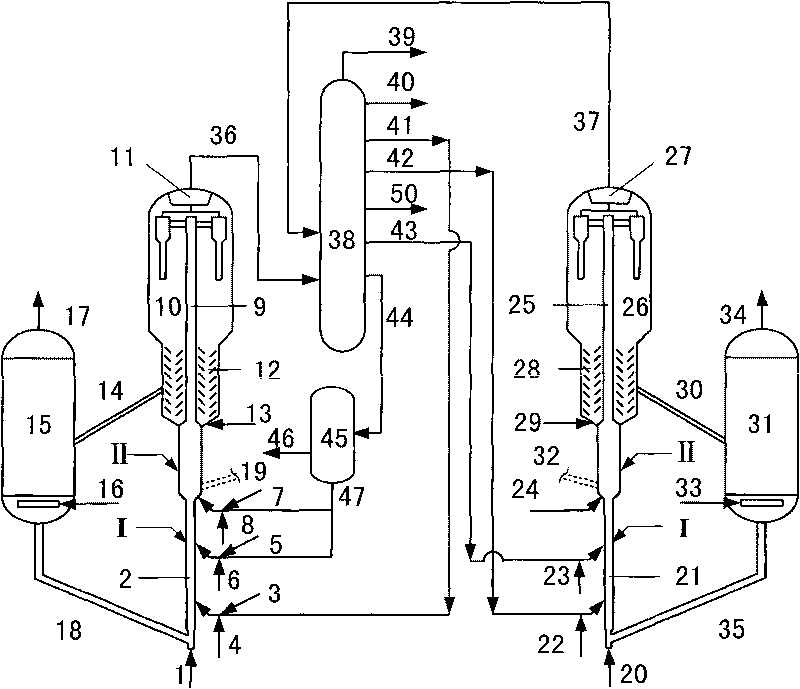Catalytic conversion method for preparing propylene and high octane gasoline
A high-octane gasoline, catalytic conversion method technology, applied in catalytic cracking, cracking, organic chemistry and other directions, can solve the problems of underutilization of low-carbon olefin potential content, low yield of propylene and aromatic hydrocarbons, etc., and achieve dry gas production. rate reduction, gasoline yield increase, selectivity increase effect
- Summary
- Abstract
- Description
- Claims
- Application Information
AI Technical Summary
Problems solved by technology
Method used
Image
Examples
Embodiment approach 1
[0050] The preferred technical solution of this embodiment comprises the following steps:
[0051] The two reactors are respectively suitable for different catalyst A and catalyst B.
[0052] In the first reactor:
[0053] (1) The refractory raw material enters the bottom of the first reaction zone and contacts with the thermally regenerated catalyst A at a reaction temperature of 600°C-750°C and a weight hourly space velocity of 100h -1 -800h -1 , the reaction pressure is 0.10MPa-1.0MPa (absolute pressure), the weight ratio of catalytic cracking catalyst and raw material is 30-150, and the weight ratio of water vapor and raw material is 0.05-1.0 to carry out the cracking reaction;
[0054] (2) The reaction effluent is mixed with the easily cracked raw material entering from the middle and upper part of the first reaction zone without being separated by an oil agent. -1 -300h -1 The cracking reaction is carried out under the conditions that the reaction pressure is 0.10MPa...
Embodiment approach 2
[0064] The preferred technical solution of this embodiment comprises the following steps:
[0065] The two reactors are respectively suitable for different catalyst A and catalyst B.
[0066] In the first reactor:
[0067] (1) The refractory raw material enters the bottom of the first reaction zone and contacts with the thermally regenerated catalyst A at a reaction temperature of 600°C-750°C and a weight hourly space velocity of 100h -1 -800h -1 , the reaction pressure is 0.10MPa-1.0MPa (absolute pressure), the weight ratio of catalytic cracking catalyst and raw material is 30-150, and the weight ratio of water vapor and raw material is 0.05-1.0 to carry out the cracking reaction;
[0068] (2) The reaction effluent is mixed with the easily cracked raw material entering from the middle and upper part of the first reaction zone without being separated by an oil agent. -1 -300h -1 The cracking reaction is carried out under the conditions that the reaction pressure is 0.10MPa...
Embodiment approach 3
[0078] The preferred technical solution of this embodiment comprises the following steps:
[0079] The two reactors are respectively suitable for different catalyst A and catalyst B.
[0080] In the first reactor:
[0081] (1) The refractory raw material enters the bottom of the first reaction zone and contacts with the thermally regenerated catalyst A at a reaction temperature of 600°C-750°C and a weight hourly space velocity of 100h -1 -800h -1 , the reaction pressure is 0.10MPa-1.0MPa (absolute pressure), the weight ratio of catalytic cracking catalyst and raw material is 30-150, and the weight ratio of water vapor and raw material is 0.05-1.0 to carry out the cracking reaction;
[0082] (2) The reaction effluent is mixed with the easily cracked raw material entering from the middle and upper part of the first reaction zone without being separated by an oil agent. -1 -300h -1 The cracking reaction is carried out under the conditions that the reaction pressure is 0.10MPa...
PUM
| Property | Measurement | Unit |
|---|---|---|
| motor octane number | aaaaa | aaaaa |
Abstract
Description
Claims
Application Information
 Login to View More
Login to View More - R&D
- Intellectual Property
- Life Sciences
- Materials
- Tech Scout
- Unparalleled Data Quality
- Higher Quality Content
- 60% Fewer Hallucinations
Browse by: Latest US Patents, China's latest patents, Technical Efficacy Thesaurus, Application Domain, Technology Topic, Popular Technical Reports.
© 2025 PatSnap. All rights reserved.Legal|Privacy policy|Modern Slavery Act Transparency Statement|Sitemap|About US| Contact US: help@patsnap.com



